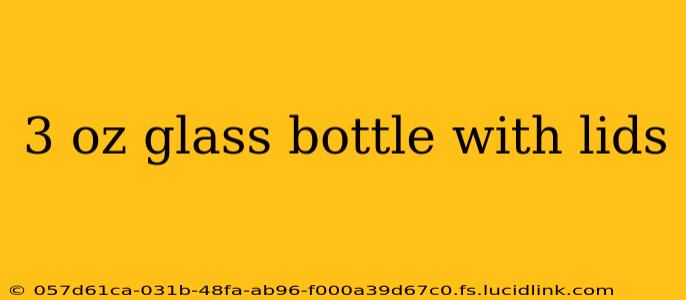Finding the right packaging for your products can be a challenge, but it's crucial for preserving quality and presenting a professional image. If you're searching for 3 oz glass bottles with lids, you've come to the right place. This comprehensive guide will help you navigate the options, understand the different types of lids, and consider factors like material and intended use. We'll also address some frequently asked questions to ensure you make an informed decision.
What are 3 oz Glass Bottles Used For?
3 oz glass bottles are incredibly versatile and suitable for a wide range of applications. Their small size makes them ideal for:
- Essential Oils: The airtight seal of a glass bottle protects the delicate compounds in essential oils from degradation.
- Cosmetics and Skincare: Serums, lotions, and other skincare products benefit from the protective and aesthetically pleasing nature of glass.
- Pharmaceuticals: Certain medications or supplements might require storage in small, tamper-evident glass containers.
- Food and Beverages: Jams, preserves, honey, or even small-batch sauces can be elegantly packaged in 3 oz glass bottles.
- Samples and Gifts: These bottles are perfect for providing samples of your product or creating charming gift sets.
What Types of Lids are Available for 3 oz Glass Bottles?
The type of lid you choose depends on your specific needs and the nature of the contents. Common lid types include:
- Screw-on Caps: These are the most common and easiest to use. They provide a secure seal and are available in a variety of materials, including plastic and metal.
- Child-Resistant Caps: For products that need to be kept out of reach of children, these caps are essential. They require a specific action to open, adding an extra layer of safety.
- Dropper Caps: Ideal for essential oils and other liquids that need to be dispensed drop by drop. They offer precise control and prevent spills.
- Spray Caps: Suitable for products that need to be applied as a mist, such as certain cleaning solutions or hair sprays.
- Tamper-Evident Caps: These caps provide a clear indication if the bottle has been opened, offering security and peace of mind.
What Material are the Lids Made From?
Lids for 3 oz glass bottles are commonly made from:
- Plastic: Plastic lids are lightweight, inexpensive, and come in a wide variety of colors. However, they may not be as durable or aesthetically pleasing as metal lids.
- Metal: Metal lids (aluminum is common) are more durable and often considered more luxurious. They can enhance the overall presentation of your product.
Where Can I Find 3 oz Glass Bottles with Lids?
You can find 3 oz glass bottles with lids from a variety of suppliers, both online and offline. Many packaging supply companies specialize in containers for various industries. Online marketplaces also offer a wide selection, allowing you to compare prices and options.
Are 3 oz Glass Bottles Reusable?
Yes, 3 oz glass bottles are generally reusable, provided they are cleaned properly. This makes them an environmentally friendly option compared to single-use plastic containers. Just make sure the bottles are thoroughly cleaned and dried before reuse.
What is the Best Type of Glass for 3 oz Bottles?
The best type of glass for 3 oz bottles depends on the product being packaged. Amber glass is a popular choice for light-sensitive products like essential oils, as it protects the contents from UV degradation. Clear glass offers better visibility of the product inside.
How Do I Choose the Right Size Lid for My 3 oz Glass Bottle?
Ensure you specify the neck size (finish) of the bottle when ordering lids. The neck finish is a standardized measurement that determines which lids are compatible with your bottle. Check the specifications of the bottles you purchase to ensure correct lid compatibility.
This guide provides a comprehensive overview of 3 oz glass bottles with lids. Remember to consider your specific needs, including the type of product you're packaging, your budget, and the desired aesthetic, to make the best choice for your unique application.
